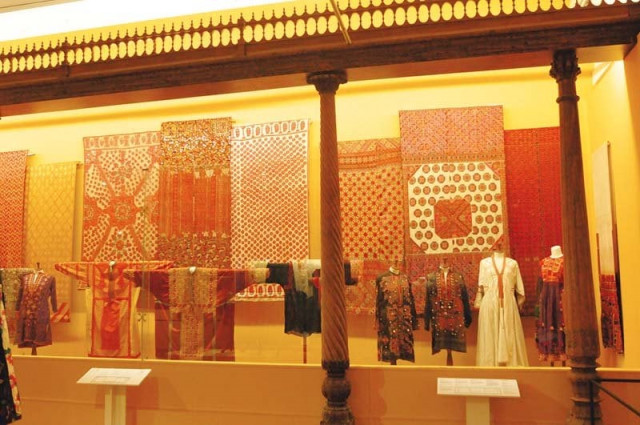Spinning yarns of identity and evolution
No ordinary fashion show, ‘A Flower from Every Meadow’ traces the rich heritage of Pakistani design tradition

According to the exhibition’s curator Nasreen Askari, two decades ago, it would have been impossible for motifs and patterns — markers of a community’s identity and heritage — to be allowed to drift from the unadulterated lexicon of tradition. While it is imperative that these traditions be safeguarded, evolution in Pakistan’s dress traditions is an inevitability that the exhibition aims to explore in detail.

Woman’s shawl (ludi) from Kutchi Rabari group, Dano Dandhal village, Nagarparkar.
The title of the exhibition, ‘A Flower from Every Meadow’, has been borrowed from the Ain-e-Akbari, written by courtier Abu’l Fazl, vizier of the Emperor and one of the nine jewels of the Mughal court, with Pakistan as the meadow and each textile a handpicked bloom. Few institutions and enterprises around the world can lay claim to the kind of authenticity that MPM celebrates in this exhibition, not only with the objects on display, but also with the organic evolution of themes that mirror the geographically and technically diverse history of Pakistan’s textile heritage as the galleries progress. After paying homage, in the first gallery, to master craftsmen — the most authentic surviving sources of the skill and tradition on display — the exhibition then progresses to printed and tie-dyed textiles, the authenticity of which is rooted in archaeological evidence dating back to the Indus Valley civilisation. Textiles in this gallery range from basic block printed or tie-dyed cloth to that adorned with silver foil and region-specific embroidered motifs, such as the woman’s shawl from the Kachi Rabari group.

Woman’s dress (jumlo), cotton embroidered with silk, buttons and zip fasteners from Indus Kohistan, Khyber-Pakhtunkhwa.
As the ambience carries us to the colder regions of the country, woven textiles are rendered authentic for their function, with thick animal fibres being used to weave shawls, coats, nomadic tents and floor rugs. A special section is dedicated to khes weaving, the most notable piece of which is a surprisingly modern checkerboard shawl that has been categorised in John Forbes Watson’s Textile Manufactures of India — one of the earliest catalogues of subcontinental textiles — as a man’s garment or cotton shawl (kass). Two contextual sub-galleries, ‘Where Mountains Meet’ and a model Baloch gidaan (tent), help visitors understand the function and geographical concentration of the types of textiles on display, especially the nomadic furnishings and animal adornments particular to itinerant Baloch tribes.
The finale of the antique collection is undoubtedly the magnificent gallery of embroidered textiles, which traces nuances of surface decoration particular to each province, mindful always of recording the stories and traditions that authenticate each object. Marking the entrance to the gallery is a series of quintessentially Baloch doch embroidered yokes (jeeg), with deliberately ordered patterns and colour combinations, from the collection of Akram Dost Baloch.

Man’s ceremonial shawl (obechan), hand spun cotton, mordant dyed, black printed and embroidered from Meghwar community, Virawah, Nagarparkar, Sindh.
The gallery opens with a tribute to the mysterious recesses of Indus Kohistan, displaying textile scholar Sheila Paine’s jumlo (dress), chuprai (double shawl) and children’s waistcoats, all adorned with a talismanic scattering of beads, buttons, zip fastenings and embroidered medallions that are thought to echo sun worship that may still be practiced in this region.
Tracing the Indus valley further south, unrivalled examples of characteristically Punjabi phulkari (flower work) are also on display, which are traditionally embroidered by a bride’s family for her trousseau. Sindhi traditions are reflected in an extensive display of gaj (blouse fronts) and bujhkis (bridal purses), which are embroidered in a particular pattern when the girl is born and completed in time for her wedding.
While each textile is the finest example of its workmanship and respective tradition, the scope of the exhibition is expanded by the royal collections that push the boundaries of textile adornment into the realm of luxury. The Khan of Kalat’s turbans and sashes (lungis) are unrivalled in their finesse, as is the gota work on the ensembles from the collection of the Nawab of Bahawalpur. The rich velvets and silks heavily embroidered in the Talpur Mirs collection are also marvels of their kind.
To illustrate the dilution of Pakistan’s textile heritage from purist and unadulterated to a beautiful amalgam of various regional traditions, nine premier designers were invited to explore this evolution through their work. This ‘tension’ between the traditional and the avant-garde in contemporary fashion forms a spectrum of its own in the final gallery; ranging from Faiza Samee, Bunto Kazmi, Rizwan Beyg and Maheen Khan’s meticulous preservation of original traditions like marorhi, zardozi, chikankari and silk weaving to Nilofer Shahid and Shamaeel Ansari’s experimentation with historical themes in their cuts and motifs, the installations become increasingly avant-garde with Sonya Battla’s contemporary renditions of bandhani and the Indus Kohistani jumlo, Khaadi’s experimentation with western silhouettes and indigo dyeing and finally Sana Safinaz’s departure from eastern cuts and hand embroidery to the commercial mechanisation of traditional aari work.

Jacket (koti) and scarf (dupatta) from the collection of the Nawab of Bahawalpur, Punjab.
Even a cursory glance through the galleries highlights, with startling clarity, the need for these objects and textile traditions to be preserved. According to Shamaeel Ansari, this is the first time in Pakistan’s fashion history that one can “trace the thread of thought from the traditional source of inspiration to its translation into a modern wearable garment within the same space”, thus making ‘A Flower from Every Meadow’ an enriching experience for historians and fashion enthusiasts alike.
Heba Hashmi is an assistant director at the Endowment Fund Trust for Preservation of the Heritage of Sindh. She has a Masters in Heritage Studies and Managing Archaeological Sites.
Published in The Express Tribune, Sunday Magazine, June 21st, 2015.



















COMMENTS
Comments are moderated and generally will be posted if they are on-topic and not abusive.
For more information, please see our Comments FAQ